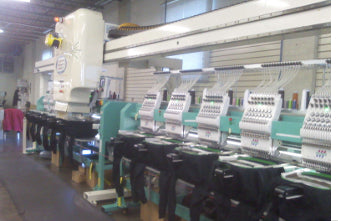How Adooka is made
How Adooka is made - the people + processes behind the clothes
 Design and development
Design and development
We (owners Anne and Shannon) work together to develop new styles. We don't live in the same state, so sometimes it gets tricky! The process goes something like this:
One of us gets an idea for something new (usually Shannon -- she is full of ideas). We talk about it over the phone, make sketches, scan them or text them to each other, talk some more. Then follows a period of mass brainstorming, lots more sketching, refining, and elimination.
At this point we also source fabric and decide on color. Many of our fabrics are custom-made for us, so we need to decide on exact weight, knitting style (interlock, rib knit, thermal), and we need to send a color sample to our mill to match. We have to source other components like buttons, and design any artwork for appliques or prints.
Once we decide on a final sketch, we create a pattern. Generally, we take shapes from patterns we already have and adapt them to what we are trying to do with the new style. If it's a totally new style, we do this ourselves, so we can experiment. Then one of us sews up a first sample, and we fit it by trying it on live bodies (not dress forms). The picture on the left is of Anne doing a fitting. We take lots of photos and send them to each other, or we skype if we need to see how the child moves in the garment. We decide what we like, what we don't like, and then we make pattern changes and another sample. When we're happy with the fit and design, we talk to our factory to see if there are any sewing issues that need to be dealt with in the production pattern, or if there is anything in the design that will be problematic in sewing. If all is good, we send the pattern and sample off to the patternmaker to have a production pattern made.

 Fabric printing
Fabric printing
We design our own prints for Adooka Organics. It's a labor-intensive process, done all by hand-drawing. Anne draws in opaque black ink onto clear mylar, then scans the mylar into a digital file. Anne has made her design so that it will work when repeated in every direction. She takes the digital file and repeats it until the file is the width of our fabric, and about a yard high (it's a really big file!).
Our fabric printer, Charles, takes over from here. He burns the design into an enormous screen (around 3' x 5'). He prints one frame at a time, every other frame, on very long tables with lots of fans going to allow the ink to dry before the screen touches it again. You can see Charles and this process in the photo -- it's a little hard to see because the ink is a light gray. Then he goes back and prints the frames in between, precisely matching them up every time (he's truly amazing at this).

 Cutting
Cutting
The cutting room is in an old brick building in Philadelphia. The man who runs the cutting business is an older gentleman who has been doing this for decades, and cuts for brands big and small (he was shy, so you won’t get to see him - this photo is of one of his cutters). The room is large, with high ceilings, windows all around, and rows of lights suspended over each of the very long tables.
Here’s how the cutting works: The cutter spreads the fabric back and forth in layers called “plies”. If I am making 200 dresses, and I have 5 sizes, the cutter will spread 40 plies of fabric. He uses a vertical knife suspended from above to cut out the pattern pieces. He cuts through all 40 plies at once, and ends up with stacks of each piece (40 size 2T fronts, 40 size 2T backs, etc.), which he bundles together, leaving the printout piece on top so the factory will know what each bundle is.

 Embroidery & applique
Embroidery & applique
Our embroidery is done by a family-run company that has been in business in Pennsylvania since 1964. They are wonderful people and do beautiful work.
A worker digitizes our applique design and programs it into the laser cutter (see photo -- this is a massive machine!). Then Tom, the laser expert, puts an embroidery hoop around the applique area, with the applique fabric on top and a water-soluble backing paper underneath, and lines it up perfectly on the embroidery machine. The machine traces a "hold-down" stitch to attach the applique fabric to the garment, then the laser machine travels until it is hovering directly overhead, and cuts the applique design. Tom removes the excess fabric, and the embroidery machine finishes the embroidery stitching. Finally, a worker steams the finished applique.

 Sewing
Sewing
Adooka is sewn by a small shop in Philadelphia owned and run by a mother-daughter team, Chau and Thao. Chau, who has been sewing since 1985, had a dream to own her own shop, and in 2005 she and Thao launched their joint venture. Thao is pure sunshine (rare in an industry full of problems, glitches and last-minute rushes). Our cutter recently asked her, "Why are you always so happy?"
First they make a fit sample to check the pattern, then a prototype in the actual fabric to work out production issues, then finally the production. They are fabulous at what they do. Their quality is outstanding, and Thao expertly manages the complicated details that go into our styles. We are so grateful to have their amazing production team, and to be collaborating with such a successful, young, woman-owned business.


